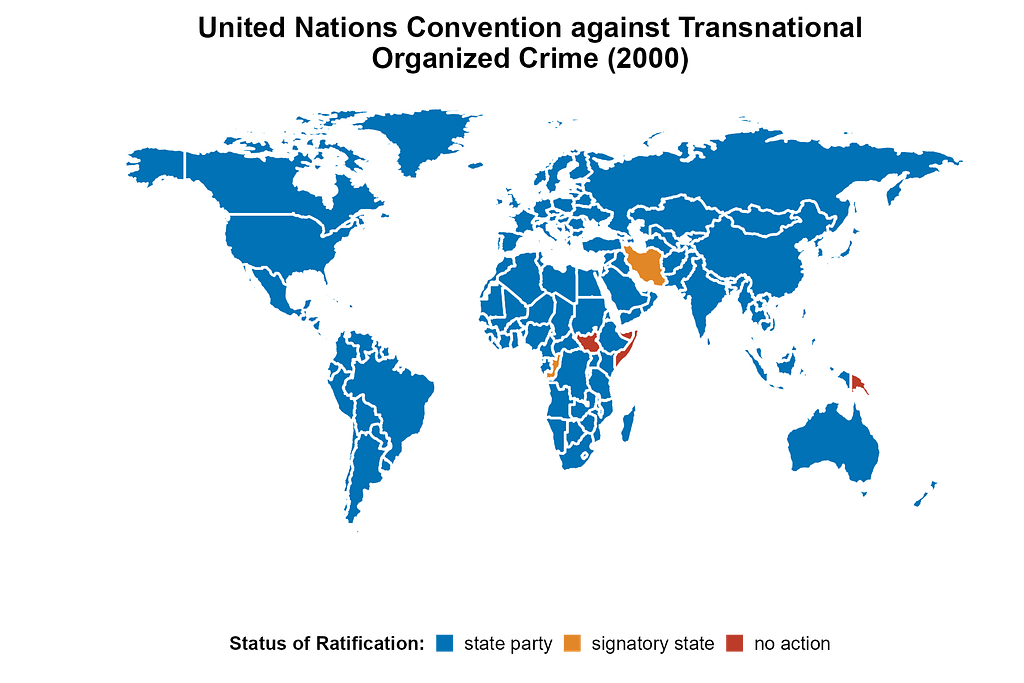CHRISTINE JOSEPH & GUSTAVO AZEVEDO
In this post, we examine the ratification status of the United Nations Convention Against Transnational Organized Crime (UNTOC), which entered into force on September 29, 2003. It is composed of three supplementary protocols, collectively referred to as the Palermo Protocols, each addressing three distinct aspects of organized crime: The Protocol to Prevent, Suppress and Punish Trafficking in Persons, Especially Women and Children, Protocol Against the Smuggling of Migrants by Land, Sea, and Air, Protocol Against the Illicit Manufacturing of and Trafficking in Firearms. These protocols are instrumental in shaping international law concerning human trafficking, arms trafficking, and money laundering. The United Nations Office on Drugs and Crime (UNODC) is entrusted with the responsibility of overseeing the UNTOC and its protocols.
The UNTOC serves as the primary international legal instrument to combat organized crime, but its efficacy hinges on the commitment and implementation efforts of member states. For instance, the convention mandates a minimum sentence of four years of imprisonment for transnational organized criminal offenses. Therefore, the status of ratification becomes pivotal, as it determines the degree to which nations align their legal systems and resources with the framework established by the UNTOC.
To assess the ratification status of this treaty, we employed the ggplot2 package in R to generate a choropleth map. This map classifies states into three distinct groups based on data retrieved from the UN Treaty Collection’s website: “state party,” “signatory state,” or “no action.” “State party” designates states that have ratified or taken further action beyond signing the treaty. Meanwhile, “signatory state” refers to those that have signed but not yet ratified the treaty. Lastly, “no action” signifies states that have neither ratified nor signed the treaty.

As of February 27, 2023, the UNTOC boasts an impressive count of 191 parties, encompassing 186 UN member states. However, seven UN member states are yet to become parties to the convention, some having signed but not ratified it. The reasons for non-ratification vary; for instance, Iran’s internal political debate and hesitance to fully embrace the convention are evidenced by Supreme Leader Ali Khamenei’s intervention. It is important to note that a country’s ratification of the treaty does not guarantee strict adherence to its terms, but rather signifies their agreement and determination to enforce the treaty’s principles. This commitment affects a country’s internal and international policies, expecting further steps to ensure compliance and implementation at the national level.
It is difficult to assess whether UNTOC’s state parties have implemented all of its provisions in their national legislation or whether such legislation has improved international efforts to combat transnational organized crime. As Cecily Rose notes, UNTOC’s Review Mechanism is not yet operational. However, evidence shows that UNTOC is making a difference. While an exhaustive review is beyond the scope of this post, a recent study indicates Indonesia’s utilization of UNTOC to bolster its endeavors in combating firearm smuggling. This has been manifested through various strategic measures, including signing mutual legal assistance agreements, collaborating with ASEAN countries, establishing extradition pacts, actively engaging in ICPO-Interpol activities, and reinforcing existing national laws, such as Law No. 15/2003 concerning terrorism.
In summary, UNTOC serves as a pivotal global treaty aimed at combating the pervasive threat posed by transnational organized crime. With the majority of countries becoming state parties to the UNTOC, there is hope that other countries will soon join this collective initiative, fostering a safer and more cooperative world.
Want to learn more about this legal instrument?
Data on this convention’s ratification status is available on the World Politics Data Lab’s GitHub page. The most recent dataset was uploaded to the repository on October 1, 2023.
For more information on the convention’s history and its current application, please refer to the following academic writings:
Rose, C. (2020) “The Creation of a Review Mechanism for the UN Convention Against Transnational Organized Crime and Its Protocols,” American Journal of International Law, 114(1): 51-67.
Tennant, I. (2021) “Fulfilling the Promise of Palermo? A Political History of the UN Convention Against Transnational Organized Crime,” Journal of Illicit Economies and Development, 2(1): 53-71
About the authors:
Christine Joseph is a senior majoring in Political Science with minors in Law, Justice, and Society and International Relations at Drew University.
Gustavo Augusto Azevedo De Jesus Freire Santos is a junior, double majoring in Economics and International Relations at Drew University.
Editor’s note: This post is part of a long-term project. Students enrolled in Drew University’s Semester on the United Nations, Principles in International Law and International Human Rights have been and will be collecting data on the ratification status of treaties deposited in the United Nations Treaty Collection. For more information on this project and its learning goals, click here.


